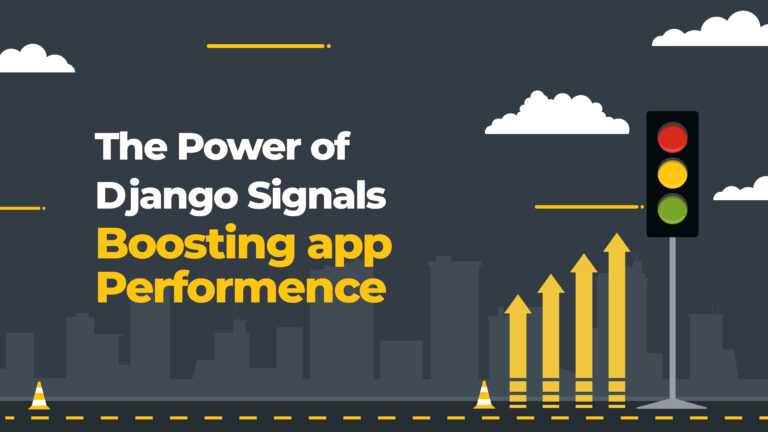In creating websites and apps, Django Signals is like a superhero tool. It’s a cool feature in Django, a powerful tool that helps developers make their apps work and perform better. Imagine it as a behind-the-scenes helper, making sure different parts of your app talk to each other smoothly. So, let’s dive into “The Power of Django Signals: Boosting App Performance” together. We’ll explore how this tool, Django Signals, makes Django apps even more awesome.
Think of Django Signals as a kind of conductor at a concert, coordinating everything quietly but powerfully. We’ll break down how Django Signals works and see how it can make your apps better.
We won’t just talk theory; we’ll show you how to use Django Signals in your own projects. We’ll use examples to help you understand how real developers use this tool to solve problems and make apps that users love.
But learning something new always has its challenges. We’ll guide you through the tricky parts, sharing tips to help you use Django Signals without any problems.
And we won’t stop at the basics. We’ll also look at some advanced stuff, showing you how to make your app faster, smarter, and ready for lots of users—all thanks to Django Signals.
By the end, you won’t just know about Django Signals; you’ll see how it can transform the way you make websites and apps. Excited to start this journey? Let’s explore the superpowers of Django Signals together!
Understanding the Magic Behind Django Signals
Django Signals, often likened to magic, is a powerful system facilitating communication within your app. At its core, Signals enable different components of your Django application to talk to each other without direct coupling. Here’s a breakdown of this magic:
Event-Driven Communication:
Think of Django Signals as a notification system. When a particular event occurs in one part of your app (let’s say, a new user signs up), Django Signals can send a signal to other parts of the app, triggering actions.
Decoupled Components:
In traditional programming, components are often tightly coupled, meaning a change in one can affect others. With Signals, components remain loosely coupled. A change in one doesn’t necessarily impact others directly.
Defining Signals:
You define signals by creating sender and receiver functions. The sender function triggers a signal, and the receiver function responds to that signal.
Built-in Django Signals:
Django comes with built-in signals. For instance, the `post_save` signal is sent when a model’s `save` method is called, allowing you to perform actions after an object is saved.
Flexibility in Implementation:
Suppose you want to send a welcome email to a new user. Instead of including email-sending logic in the user creation view, you can use Signals. The user creation view sends a signal, and a separate function handles the email-sending task.
Loosening Dependencies:
Without Signals, changes in one part of your app might require changes in other parts. With Signals, you can add new features or make changes without directly modifying existing components.
Understanding these foundational aspects of Django Signals sets the stage for exploring how they can enhance your app’s capabilities. Now, let’s move on to adding superpowers to your Django app with Signals!
Supercharging Django Apps with Signals: Practical Implementation Tips
Welcome to the practical realm of Django Signals, where the magic transforms into tangible enhancements for your app. Here, we’ll delve into actionable tips and tricks for supercharging your Django applications using Signals:
Identifying Use Cases:
Before implementing Signals, identify scenarios where different parts of your app need to communicate. For instance, sending a notification when a user profile is updated.
Creating Custom Signals:
Don’t limit yourself to built-in signals. Create custom signals tailored to your app’s specific needs. If you’re building an e-commerce platform, a custom signal could be triggered when a new order is placed.
Deciding Signal Types:
Django Signals come in two types – `pre` and `post`, so choose wisely based on when you want to send the signal . For instance, use `pre_save` if you want to perform an action before saving an object.
Utilising Django’s Built-in Signals:
Leverage signals like `post_save` and `pre_delete` for instance, use `post_save` to update related data after saving an object or `pre_delete` to perform actions before an object is deleted.
Connecting Multiple Receivers:
Django Signals allow multiple functions (receivers) to respond to a single signal. If, for instance, you want to send both an email and a push notification when a new comment is posted, set up multiple receivers.
Optimising Database Queries:
Use Signals to optimise database queries. Instead of querying the database each time a related action occurs, use Signals to update or fetch data precisely when needed.
Error Handling with Signals:
Implement error-handling mechanisms within your Signal functions. If, for instance, sending an email fails, handle the error gracefully to avoid disrupting the entire process.
Testing Signal Functions:
Rigorously test your Signal functions to ensure they perform as expected. Tools like Django’s Test-Case class can be invaluable for testing the behaviour of your signals in different scenarios.
Documentation: A Best Practice:
Document your Signals comprehensively. Include details about the purpose of each signal, when it’s triggered, and the expected behaviour of associated functions. This documentation aids collaboration and future development.
Monitoring and Debugging:
Implement monitoring and logging for your Signal functions. It will facilitate debugging and provide insights into how signals behave in a live environment.
By embracing these tips, you’re not just implementing Django Signals; you’re optimising, customising, and future-proofing your app’s architecture. Let’s now transition to the final part of our journey and explore advanced techniques for mastering Django Signals.
Solving Real-world Challenges with Django Signals
In the realm of Django Signals, real-world challenges demand innovative solutions. Let’s explore how to tackle common issues and enhance your Django app’s robustness using Signals:
Combining Signals with Celery:
For extensive background processing, integrate Django Signals with Celery. This asynchronous task queue helps manage time-consuming operations effectively:
from celery import shared_task
@shared_task
def async_function(user_id):
# Async logic here
Asynchronous Signal Handling:
Address scenarios where synchronous signal handling might cause delays. Utilize Django’s @receiver decorator with django.db.transaction.on_commit for asynchronous processing:
from django.db import transaction
@receiver(post_save, sender=User)
def handle_new_user(sender, instance, **kwargs):
transaction.on_commit(lambda: async_function.delay(instance.id))
Handling Multiple Signals:
Effectively manage scenarios where multiple signals need to be coordinated. Use the django.dispatch.Signal.connect method to connect multiple signals to a single receiver function:
post_save.connect(handle_user, sender=User)
post_save.connect(handle_profile, sender=UserProfile)
Custom Signals for Custom Logic:
Tailor signals to your app’s unique needs. Create custom signals to trigger specific events, enhancing the flexibility of your application:
custom_signal = Signal()
@receiver(custom_signal)
def handle_custom_signal(sender, **kwargs):
# Custom logic here
Dynamic Signal Connection:
Dynamically connect signals based on runtime conditions, providing a dynamic and flexible architecture:
def connect_signals():
if some_condition:
post_save.connect(handle_condition_a, sender=User)
else:
post_save.connect(handle_condition_b, sender=User)
Conditional Signal Disconnect:
In certain scenarios, you might need to disconnect a signal conditionally. Django provides a way to disconnect signals dynamically:
if disconnect_condition:
post_save.disconnect(handle_user, sender=User)
Ensuring Signal Order:
django.dispatch.Signal.disconnect
Control the order in which multiple signals are executed by using the django.dispatch.Signal.disconnect method:
post_save.disconnect(handle_profile, sender=UserProfile)
post_save.connect(handle_profile, sender=UserProfile)
Signal Decoupling for Modularity:
Decouple your app’s components by using Django Signals for inter-app communication. This enhances modularity, making your app more maintainable:
# In app_a
custom_signal = Signal()
# In app_b
@receiver(app_a.signals.custom_signal)
def handle_custom_signal(sender, **kwargs):
# Logic in app_b
Monitoring and Logging:
Implement robust monitoring and logging for signals. Tools like Django Debug Toolbar or Sentry can help identify and address issues efficiently.
Performance Considerations:
Be mindful of performance implications. While Signals provide immense flexibility, excessive use or poorly optimised handlers may impact performance. Regularly profile and optimise your signal-handling functions.
With these advanced techniques, you’re not just solving challenges; you’re elevating your Django app’s architecture to handle real-world complexities. Let’s now delve into the nuanced art of debugging and optimising Django Signals for peak performance.
A Step Further – Advanced Signal Techniques
Now that we’ve mastered the basics, let’s venture into the advanced realm of Django Signals. These techniques will propel your app development to new heights, ensuring not just functionality but elegance in design:
Dynamic Signal Connection with Decorators:
Leverage custom decorators to dynamically connect signals. This adds a layer of abstraction, making your code cleaner and more readable:
def dynamic_signal(sender, **kwargs):
# Dynamic logic here
@dynamic_receiver(post_save, sender=User)
def handle_user(sender, **kwargs):
# Standard handling logic
Fine-tuning Signal Execution with dispatch_uid:
Use dispatch_uid to uniquely identify signal connections. This helps in avoiding accidental duplicate connections and allows fine-tuned control over signal execution:
post_save.connect(handle_user, sender=User, dispatch_uid="unique_identifier")
Conditional Signal Connection Using @receiver Options:
Explore the powerful options available with the @receiver decorator. Conditionally connect signals based on dynamic factors:
@receiver(post_save, sender=User, dispatch_uid="unique_id", weak=False, reuse_connection=True)
def handle_user(sender, **kwargs):
# Advanced logic here
Bulk Signal Handling with django.db.models.signals.pre_bulk_insert and post_bulk_insert:
Optimise database interactions by using bulk insert signals. These signals provide hooks before and after bulk data operations, enabling efficient handling:
@receiver(pre_bulk_insert, sender=User)
def pre_bulk_insert_handler(sender, **kwargs):
# Logic before bulk insert
@receiver(post_bulk_insert, sender=User)
def post_bulk_insert_handler(sender, **kwargs):
# Logic after bulk insert
Integrating Django Signals with Django Channels:
For real-time capabilities, seamlessly integrate Django Signals with Django Channels. This opens the door to asynchronous communication and live updates:
# consumers.py
@receiver(post_save, sender=User)
async def handle_user(sender, **kwargs):
# Asynchronous logic with Django Channels
Handling Signal Exceptions Gracefully:
Implement error-handling strategies for robust applications. Wrap signal handling logic in try-except blocks and log exceptions for thorough debugging:
@receiver(post_save, sender=User)
def handle_user(sender, **kwargs):
try:
# Advanced logic here
except Exception as e:
logger.error(f"Error in signal handling: {e}")
Using Django Signals in Data Migrations:
Extend the power of Django Signals to data migrations. This enables you to execute custom logic during database migrations:
# in migration file
post_save.connect(handle_user, sender=User)
Rate Limiting Signal Handlers:
Implement rate limiting for signal handlers to control the frequency of execution. This is crucial for scenarios where rapid-fire signals may cause unintended side effects:
from django_ratelimit.decorators import ratelimit
@ratelimit(key="user", rate="10/m", method="post", block=True)
@receiver(post_save, sender=User)
def handle_user(sender, **kwargs):
# Logic here
Dynamically Disconnecting Signals:
Explore scenarios where dynamic signal disconnection is beneficial. Disconnect signals based on runtime conditions for optimal flexibility:
def disconnect_signals():
if disconnect_condition:
post_save.disconnect(handle_user, sender=User)
Performance Profiling and Optimisation:
Dive into the nuances of performance profiling for signal handlers. Tools like Django Debug Toolbar and django-silk can aid in identifying bottlenecks and optimising your code.
With these advanced signal techniques, you’re not just handling events; you’re orchestrating a symphony of efficiency and elegance in your Django application. Let’s now journey into the world of debugging and testing, ensuring your signals perform flawlessly in any scenario.
Putting Knowledge into Action – Practical Examples
Now that we’ve gathered a wealth of knowledge on Django Signals, let’s transition from theory to practical application. Through hands-on examples, you’ll gain a deeper understanding of how to implement signals in real-world scenarios:
User Profile Creation on Registration:
Utilise the post_save signal to automatically create a user profile upon user registration. This ensures a seamless experience for users, eliminating the need for manual profile creation:
from django.db.models.signals import post_save
from django.dispatch import receiver
from django.contrib.auth.models import User
from .models import UserProfile
@receiver(post_save, sender=User)
def create_user_profile(sender, instance, created, **kwargs):
if created:
UserProfile.objects.create(user=instance)
Automated Email Notifications on Model Changes:
Implement a notification system by sending automated emails when specific model changes occur. This example uses the post_save signal to trigger email notifications:
from django.core.mail import send_mail
@receiver(post_save, sender=YourModel)
def send_notification_email(sender, instance, **kwargs):
send_mail(
'Subject',
'Message',
'from@example.com',
['to@example.com'],
fail_silently=False,
)
Real-time Data Updates with Django Channels:
Extend your app’s capabilities by integrating Django Signals with Django Channels for real-time updates. This example demonstrates broadcasting model changes to connected clients:
from channels.layers import get_channel_layer
from asgiref.sync import async_to_sync
@receiver(post_save, sender=YourModel)
def broadcast_changes(sender, instance, **kwargs):
channel_layer = get_channel_layer()
async_to_sync(channel_layer.group_send)(
"realtime_group",
{"type": "send_realtime_update", "message": "Data updated!"},
)
Audit Trail for Model Changes:
Implement an audit trail to track changes to your models. The post_save and post_delete signals can be harnessed to record modifications and deletions:
from django.contrib.admin.models import LogEntry, ADDITION, CHANGE, DELETION
@receiver([post_save, post_delete], sender=YourModel)
def log_model_changes(sender, instance, **kwargs):
LogEntry.objects.log_action(
user_id=instance.user.id,
content_type_id=get_content_type_for_model(instance).id,
object_id=instance.id,
object_repr=str(instance),
action_flag=ADDITION if kwargs.get("created") else CHANGE if kwargs.get("updated_fields") else DELETION,
)
Dynamic Signal Connection Based on User Role:
Tailor your signal connections dynamically based on user roles. This ensures that certain signals are activated only for users with specific roles:
@receiver(post_save, sender=YourModel)
def handle_model_changes(sender, instance, **kwargs):
if instance.user.role == 'Admin':
# Admin-specific logic
elif instance.user.role == 'Regular':
# Regular user logic
Rate Limiting User Actions:
Apply rate limiting to user actions to prevent abuse or rapid-fire requests. In this example, the django_ratelimit library is used to restrict certain actions:
from django_ratelimit.decorators import ratelimit
@ratelimit(key="user", rate="10/m", method="post", block=True)
@receiver(post_save, sender=YourModel)
def handle_model_changes(sender, instance, **kwargs):
# Logic here
Signal Disconnect Based on User Preferences:
Empower users with the ability to customise their experience by dynamically disconnecting certain signals based on their preferences:
def disconnect_user_signals(user):
if user.disable_notification:
post_save.disconnect(send_notification_email, sender=YourModel)
Bulk Data Handling with Signals:
Optimise your app’s performance when dealing with bulk data. Employ signals to handle pre and post operations during bulk data handling:
@receiver(pre_bulk_insert, sender=YourModel)
def pre_bulk_insert_handler(sender, **kwargs):
# Logic before bulk insert
@receiver(post_bulk_insert, sender=YourModel)
def post_bulk_insert_handler(sender, **kwargs):
# Logic after bulk insert
Integration with External APIs on Model Changes:
Utilise Django Signals to trigger actions like sending data to external APIs when certain model changes occur:
import requests
@receiver(post_save, sender=YourModel)
def send_data_to_api(sender, instance, **kwargs):
# Logic to send data to external API
Advanced Debugging Techniques:
Implement advanced debugging techniques to troubleshoot signal-related issues. Utilise tools like Django Debug Toolbar and logging to gain insights into signal execution and performance.
By applying these practical examples, you’ll not only grasp the technicalities of Django Signals but also witness their transformative impact on real-world applications. The next section will guide you through debugging strategies and testing methodologies, ensuring your signals operate flawlessly in diverse scenarios.
Troubleshooting and Best Practices
As you embark on the journey of implementing Django Signals, it’s crucial to be equipped with troubleshooting techniques and best practices. This section delves into common challenges and offers insights into optimising your signal-driven applications:
Logging Signal Activities:
Implement detailed logging to keep track of signal activities. This is especially valuable during development and debugging phases. Utilise Django’s built-in logging system to record signal executions:
import logging
logger = logging.getLogger(__name__)
@receiver(post_save, sender=YourModel)
def log_signal_activity(sender, instance, **kwargs):
logger.info(f"Signal triggered for {instance} in {sender}.")
Using Django Debug Toolbar for Signal Analysis:
Leverage tools like Django Debug Toolbar to analyse the execution of signals. This powerful debugging tool provides insights into SQL queries, signals, and overall performance. Ensure it’s properly configured in your Django project for effective signal analysis.
Handling Circular Dependencies:
Be cautious of circular dependencies, a common pitfall when working with signals. Circular dependencies can lead to unexpected behaviour. Mitigate this by employing techniques such as importing models within functions rather than at the module level.
Unit Testing Signal Functions:
Ensure your signal functions are thoroughly tested. Use Django’s Test-Case and override the setUp method to disconnect specific signals during testing. This guarantees that your tests remain isolated and don’t interfere with actual signal behaviour.
from django.test import TestCase
class YourModelTestCase(TestCase):
def setUp(self):
post_save.disconnect(your_signal_function, sender=YourModel)
def tearDown(self):
post_save.connect(your_signal_function, sender=YourModel)
Signal Execution Order:
Familiarise yourself with the order of signal execution. Django executes signals in a specific order, which may impact the outcome of your application. Be aware of the @transaction.atomic decorator and its implications on signal execution.
Dealing with Asynchronous Signal Handling:
If you’re working with asynchronous Django, be mindful of how signals are handled asynchronously. Ensure that your signals and corresponding functions are compatible with the chosen asynchronous framework, such as Django Channels or Celery.
Managing Signal Disconnects:
Dynamically disconnecting and reconnecting signals can be error-prone if not managed carefully. Implement a clear strategy for when and why signals should be disconnected, and document these decisions for future reference.
Monitoring Signal Performance:
Keep a close eye on the performance impact of signals, especially in scenarios with high-frequency operations. Utilise Django Debug Toolbar and performance monitoring tools to identify any bottlenecks caused by signal processing.
Graceful Handling of Signal Exceptions:
Implement graceful exception handling within your signal functions. Unhandled exceptions in signal functions can disrupt the normal flow of your application. Use try-except blocks to catch exceptions and handle them appropriately.
@receiver(post_save, sender=YourModel)
def handle_signal_exception(sender, instance, **kwargs):
try:
# Your signal logic here
except Exception as e:
logger.error(f"Exception in signal handling: {e}")
Documentation and Code Comments:
Comprehensive documentation and well-placed code comments are your allies in signal-driven development. Clearly document the purpose, expected behaviour, and any potential gotchas of your signal functions to aid both yourself and other developers.
By navigating these troubleshooting techniques and adhering to best practices, you’ll fortify your Django Signals implementation against potential issues and ensure a robust, efficient application. The final section, “Conclusion,” will recap key takeaways and encourage further exploration of Django’s powerful features.
Making Your App Lightning Fast – Performance Optimisation with Signals
Ensuring that your Django-powered app operates at optimal speed is crucial for delivering a seamless user experience. This section dives into strategies for performance optimisation using Django Signals:
Selective Signal Connection:
Rather than connecting signals for every operation, selectively connect signals based on the necessity of real-time updates. This minimise unnecessary signal processing and contributes to faster response times.
from django.db.models.signals import post_save
from django.dispatch import receiver
@receiver(post_save, sender=YourModel)
def selective_signal_handler(sender, instance, **kwargs):
# Your selective signal handling logic here
Batch Processing with Django’s bulk_create:
When dealing with a large number of records, leverage Django’s bulk_create for efficient batch processing. Minimise the number of individual signals triggered during bulk operations to enhance overall performance.
YourModel.objects.bulk_create([YourModel(**data) for data in batch_data])
Asynchronous Signal Handling:
Explore asynchronous signal handling for operations that don’t require immediate processing. Asynchronous signals, combined with frameworks like Django Channels or Celery, can significantly boost performance by offloading non-time-sensitive tasks.
from django.db.models.signals import post_save
from django.dispatch import receiver
from asgiref.sync import async_to_sync
import channels.layers
@receiver(post_save, sender=YourModel)
def asynchronous_signal_handler(sender, instance, **kwargs):
layer = channels.layers.get_channel_layer()
async_to_sync(layer.group_send)("performance_group", {"type": "performance.update"})
Caching with Django Signals:
Integrate caching mechanisms with signals to store frequently accessed data. By strategically caching results, you can reduce the need for repetitive, resource-intensive computations.
from django.core.cache import cache
from django.db.models.signals import post_save
from django.dispatch import receiver
@receiver(post_save, sender=YourModel)
def cache_signal_handler(sender, instance, **kwargs):
cache_key = f"your_model_{instance.id}"
# Check cache first
cached_data = cache.get(cache_key)
if cached_data is None:
# Your processing logic
result = expensive_operation(instance)
# Store result in cache
cache.set(cache_key, result)
else:
result = cached_data
# Use 'result' as needed
Indexing for Query Performance:
Optimise database queries related to signal operations by ensuring relevant fields are indexed. Well-designed indexes can significantly reduce query execution time, especially in scenarios involving complex signal-driven queries.
Lazy Loading for Non-Critical Signals:
Implement lazy loading for non-critical signals that don’t require immediate attention. Delaying the execution of these signals until a less resource-intensive time can prevent performance bottlenecks during high-traffic periods.
from django.db.models.signals import post_save
from django.dispatch import receiver
@receiver(post_save, sender=YourModel)
def lazy_loading_signal_handler(sender, instance, **kwargs):
# Your lazy loading logic here
Database Sharding and Partitioning:
Explore database sharding and partitioning strategies to distribute data across multiple servers or partitions. This advanced technique can enhance database performance, especially when dealing with large datasets and high transaction volumes.
Periodic Signal Cleanup:
Implement periodic cleanup routines to manage outdated or unnecessary signal-related data. This prevents the accumulation of unnecessary records and optimises both database and application performance.
Monitoring and Profiling:
Regularly monitor and profile your application’s performance, especially focusing on signal-related operations. Tools like Django Debug Toolbar and Django Silk can provide valuable insights into performance bottlenecks.
Load Testing with Signal Scenarios:
Include signal-driven scenarios in your application’s load testing strategy. Simulating real-world scenarios with concurrent users and signal-triggered events helps identify potential performance challenges early in the development life-cycle.
By implementing these performance optimisation strategies, your Django app can not only meet but exceed expectations in terms of speed and responsiveness. As we approach the final section, “Conclusion,” the cumulative insights from each section will reinforce the mastery of Django Signals for app development.
Conclusion: Unleashing the Full Potential of Django Signals
Congratulations! You’ve now traversed the intricate landscape of Django Signals, discovering its versatility, power, and the myriad ways it can elevate your Django applications. Let’s encapsulate our journey and underscore the key takeaways:
Empowering Real-time Responsiveness:
Django Signals stand as the cornerstone for achieving real-time responsiveness in your applications. By harnessing the innate power of signals, you’ve learned how to orchestrate instant actions in response to model changes, creating a dynamic and engaging user experience.
Strategic Signal Integration:
The strategic integration of signals into your application architecture enables you to craft a responsive and event-driven ecosystem. From handling model life-cycle events to orchestrating custom signals, you’ve explored the art of leveraging signals for enhanced functionality.
Efficient Decoupling of Components:
Django Signals exemplify the concept of decoupling components within your application. This decoupling fosters modular development, making your code-base more maintainable, extensible, and adaptable to future changes.
Advanced Techniques for Optimisation:
Delving into advanced techniques, you’ve discovered how to optimise signal operations for improved performance. Whether it’s through selective connections, asynchronous handling, or incorporating caching strategies, you’re equipped to fine-tune your application’s speed and efficiency.
Real-world Problem Solving:
The section on “Solving Real-world Challenges” provided insights into addressing practical scenarios. Armed with solutions for common challenges, you’re now prepared to navigate the complexities of real-world application development.
Advanced Signal Techniques:
Going a step further into “Advanced Signal Techniques,” you’ve explored intricate methods for tailoring signals to your application’s unique needs. These advanced techniques open avenues for creativity and innovation in signal-driven development.
Practical Application Scenarios:
“Putting Knowledge into Action – Practical Examples” empowered you to translate theoretical knowledge into practical application. The provided examples demonstrated how to implement signals in real-world contexts, reinforcing the hands-on aspect of our exploration.
Troubleshooting and Best Practices:
Armed with insights from “Troubleshooting and Best Practices,” you’ve acquired the skills to identify and address common issues. The troubleshooting guide ensures that your journey with Django Signals is not only powerful but also smooth and error-resistant.
Performance Optimisation Strategies:
In “Making Your App Lightning Fast – Performance Optimisation with Signals,” you discovered strategies to optimise your application’s performance. From lazy loading to database sharding, these techniques empower you to create lightning-fast Django applications.
Unleashing Innovation and Mastery:
By mastering Django Signals, you’re not just utilising a framework feature; you’re unlocking a realm of innovation. Signals provide a canvas for you to paint your application’s functionality with precision, enabling you to unleash your creativity and build exceptional user experiences.
As you embark on applying Django Signals in your projects, remember that mastery comes with practice. Experiment, innovate, and continually explore the evolving landscape of Django development. Your journey doesn’t end here; it extends into a realm where Django Signals serve as your creative palette, and your applications become masterpieces of efficiency and functionality.
Thank you for joining us on this journey through “The Power of Django Signals.” May your future Django projects be robust, responsive, and truly extraordinary!
Elevate Your Digital Ventures with Nuventure Connect: Your Trusted IT Solutions Partner
As a leading IT staff augmentation company, Nuventure Connect specialises in delivering top-notch solutions across various domains, including web, mobile, software development, and IoT. Our commitment is centred around fostering innovation and facilitating seamless development experiences by leveraging the latest advancements in technology.
Web Development:
Our skilled professionals excel in crafting dynamic and responsive web solutions tailored to meet your unique business needs. Whether you require a robust web application or an engaging website, our team is equipped to deliver high-quality results. Explore our web development services.
Mobile App Development:
In the realm of mobile app development, we stand out as experts committed to delivering cutting-edge solutions. From conceptualisation to implementation, our team ensures a seamless and innovative approach to crafting mobile applications. Hire the best mobile developers through our portal for a development experience that exceeds expectations.
Software Development:
At Nuventure Connect, we take pride in our proficiency in software development. Our team is dedicated to delivering software solutions that align with industry standards and cater to the specific requirements of your business. Discover our software development expertise.
IoT Services:
For IoT solutions that redefine connectivity and efficiency, Nuventure Connect is your go-to partner. Our expertise in IoT extends to creating innovative and integrated solutions that enhance your business operations. Explore our IoT services for a glimpse into the future of connected technology.
Staff Augmentation:
Empower your projects with our highly skilled and dedicated professionals. Nuventure Connect offers staff augmentation services that enable you to access top-tier talent for your development needs. Learn more about staff augmentation and take the first step toward enhancing your team.
For further inquiries or to discuss your project requirements, book a call with our experts. At Nuventure Connect, we are committed to driving excellence in every facet of IT solutions, ensuring your success in the digital landscape.
Few List of Signals
Django provides a set of built-in signals that allow certain senders to notify a set of receivers when certain actions occur. Here are some of the most commonly used built-in signals in Django:
- django.db.models.signals.pre_save
Sent just before a model’s save() method is called. - django.db.models.signals.post_save
Sent just after a model’s save() method is called. - django.db.models.signals.pre_delete
Sent just before a model’s delete() method is called. - django.db.models.signals.post_delete
Sent just after a model’s delete() method is called. - django.db.backends.signals.connection_created
Sent after a new database connection is created. - django.core.signals.request_started
Sent when a Django request starts. - django.core.signals.request_finished
Sent when a Django request is finished (after the response is sent). - django.core.signals.got_request_exception
Sent when a Django request raises an exception. - django.db.backends.signals.connection_created
Sent after a new database connection is created. - django.db.backends.signals.connection_close
Sent before closing a database connection. - django.db.backends.signals.connection_recycled
Sent when a database connection is recycled. - django.db.backends.signals.connection_created
Sent after a new database connection is created.
These signals cover various stages of the Django application lifecycle and database operations. They enable you to hook into different parts of the process and execute custom logic or modifications. Keep in mind that the signal names are part of the `django.db.models.signals` or `django.core.signals` namespace, depending on the nature of the signal.




